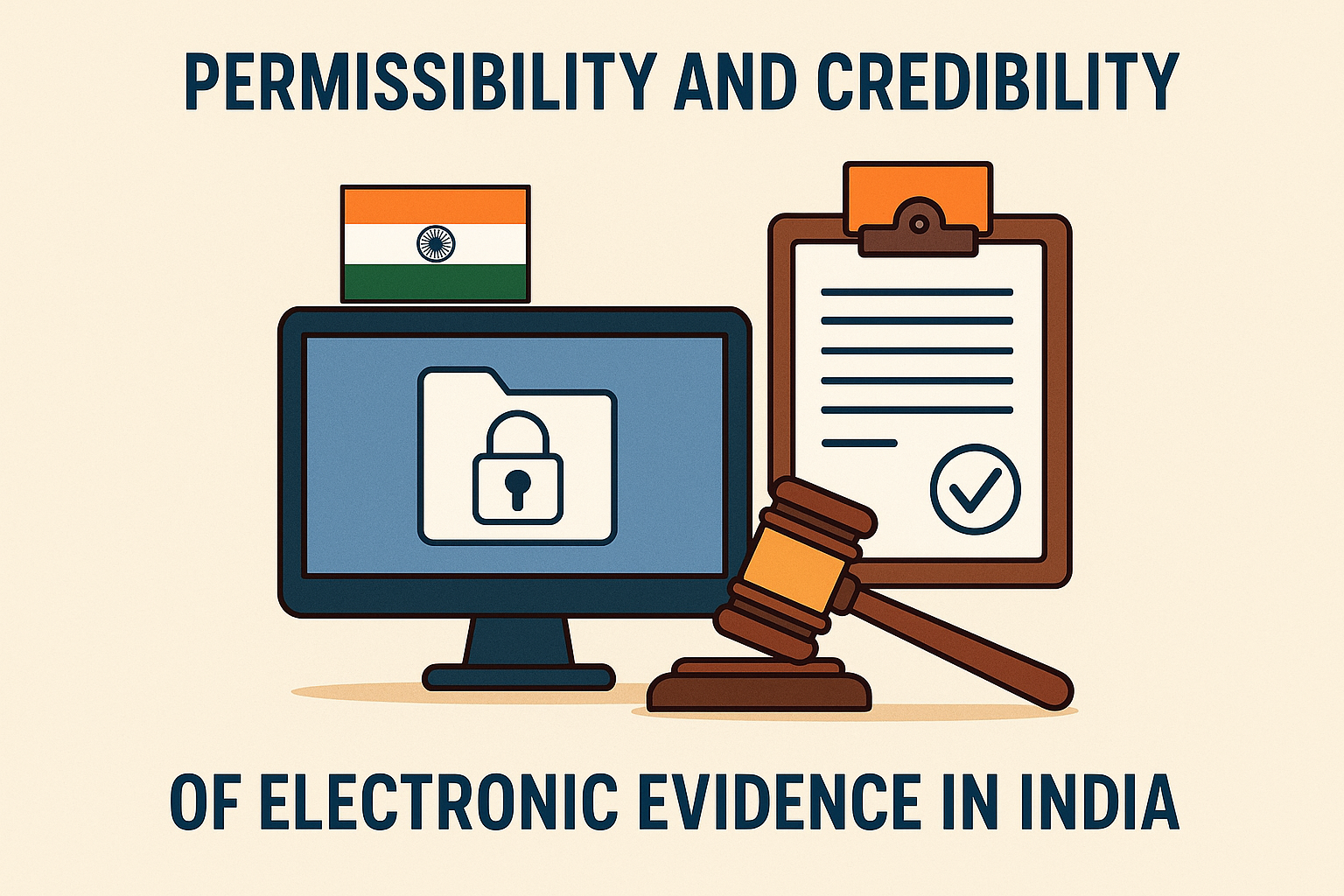View News
Permissibility and Credibility of Electronic Evidence in India

Permissibility and Credibility of Electronic Evidence in India
~Sura Anjana Srimayi
INTRODUCTION
In an era where our lives are more and more recorded and documented online, electronic records—from emails and WhatsApp chats to CCTV footage and digital photographs—have become essential evidence in both civil and criminal trials. Nevertheless, the judicial system, subject to the illustrious Indian Evidence Act, 1872, was initially formatted for a paper document and word-of-mouth testimony-based world. The digital revolution compelled a deep legal change to meet this new means of evidence. This change was officially brought about when the Information Technology (IT) Act, 2000, was passed amending the Evidence Act to cater specifically to electronic records.
The Legal Framework: Sections 65A and 65B
The foundation of electronic evidence in Indian law is established under two special provisions of the IT Act, 2000: Section 65A and Section 65B of the Indian Evidence Act, 1872. Section 65A merely says that contents of electronic records can be established in accordance with the provisions of Section 65B. This means that Section 65B is the most significant legal provision defining the admissibility of electronic evidence.
Section 65B is an independent code specifying when an electronic record should be considered a legally valid "documentary evidence" in a court of law and admissible without the production of the original device. This is significant because it makes secondary electronic evidence such as a printout, a video duplicated on a CD, or information on a pen drive admissible in a court of law. For a computerised record to be accepted as evidence under this section, four key requirements must be met:
- The computerised record must have been output by a computer that was being used from time to time to hold or process information in the relevant period.
- The information must have been fed into the computer from time to time in the normal course of the activity.
- The computer must have been working properly for the material period.
- The data in the electronic record shall be a reproduction or derived from the data input to the computer.
Moreover, Section 65B(4) imposes a particular and much disputed condition: that the electronic evidence be accompanied by a certificate. The certificate has to state the electronic record and how it was produced, detail the equipment used, and be signed by an individual in a responsible official position with respect to the operation of the device.
Judicial Precedents: From Chaos to Clarity
The enactment of these provisions generated initial uncertainty among lawyers, and it was interpreted in contradictory ways by various courts. The history of the Supreme Court's struggle with interpreting this law is a reflection of the court's dedication to keeping up with technological evolution.
Originally, in the high court case of State (NCT of Delhi) v. Navjot Sandhu (2005), the Supreme Court decided that although Section 65B laid down a particular procedure for the production of electronic records, it was optional. The court declared that electronic evidence could also be established under the general provisions contained in Sections 63 and 65 of the Evidence Act. This provided a loophole, enabling parties to bypass the stringent requirements of Section 65B, including the vital certificate.
This stance was categorically overruled by a three-judge bench of the Supreme Court in Anvar P.V. v. P.K. Basheer (2014). The Court held that Section 65B is a "complete code" in itself. It held that any electronic record offered as secondary evidence must strictly comply with all the conditions laid down in Section 65B, and that the certificate under Section 65B(4) is a mandatory precondition for admissibility. This judgment was a pivotal moment, as it emphasized the need for safeguards to prevent the tampering and manipulation of electronic evidence, which are far easier than with traditional paper documents.
The law was again consolidated in the 2020 judgment of Arjun Panditrao Khotkar v. Kailash Kushanrao Gorantyal. A Supreme Court three-judge bench re-affirmed the Anvar P.V. judgment and removed several ambiguities. It held that the certificate under Section 65B(4) is actually a condition precedent to admissibility. But it did draw an important distinction: the certificate is unnecessary if the originating electronic device (e.g., phone, laptop, or camera) that contains the core evidence itself is produced in court and the contents are established by the owner. The Court also offered a pragmatic solution for a party who does not have possession of the electronic device or cannot get the certificate. In such a situation, the party can seek a direction from the court to the person having possession of the device to provide the necessary certificate. This practical solution guards against justice being thwarted by technicality.
Credibility and Challenges
Once electronic evidence is admissible, the issue moves from one of permissibility to one of credibility. Whereas admissibility is a question of law (regulated by Section 65B), credibility is a question of fact to be decided by the court relying on the facts of the case. Judges determine the amount of weight to be accorded to electronic evidence based on a number of factors:
- Integrity: Was the electronic record kept and preserved in a safe custody?
- Chain of Custody: Is it possible to establish a clear and uninterrupted chain of custody from the moment when the evidence was created until the moment when it was brought into court?
- Authentication: Is there any sign of tampering or alteration? Expert evidence from a digital forensic specialist tends to become crucial here.
The integrity of electronic evidence is crucial, since digital data can be easily tampered with without a trace. The increasing availability of high-tech tools such as deepfakes poses a new and formidable threat to the integrity of audio and video evidence. These deepfaked media are nearly impossible to distinguish from authentic content, necessitating advanced forensic techniques and expert examination.
Though judicial precedents give legal certainty, practical issues persist. These are the absence of digital forensic facilities nationwide, the expensive nature of expert examination, and a universal dearth of digital literacy among jurists.
CONCLUSION
The electronic evidence's journey under the Indian Evidence Act, 1872, is a riveting illustration of the judiciary's accommodation to technological progress. The addition of Sections 65A and 65B, and their subsequent interpretation by the Supreme Court, has provided a strong framework for handling electronic records. The law now stands thus: in order for secondary electronic evidence to be admissible, it has to be accompanied by the mandatory certificate as set out in Section 65B(4). This stringent requirement is a necessary measure against the inherent weakness of digital data. While the permissibility law has been well and truly settled, the judiciary and lawyers continue to have to struggle with the nuance of credibility, especially in light of new technologies such as deepfakes. With our lives growing more digital, the legal principles that govern electronic evidence will continue to be an important support of justice in India's courts.
Unlock the Potential of Legal Expertise with LegalMantra.net - Your Trusted Legal Consultancy Partner”
Disclaimer: Every effort has been made to avoid errors or omissions in this material in spite of this, errors may creep in. Any mistake, error or discrepancy noted may be brought to our notice which shall be taken care of in the next edition In no event the author shall be liable for any direct indirect, special or incidental damage resulting from or arising out of or in connection with the use of this information Many sources have been considered including Newspapers, Journals, Bare Acts, Case Materials , Charted Secretary, Research Papers etc

